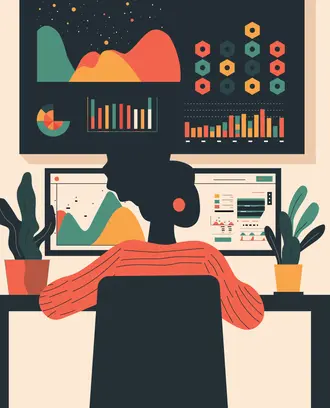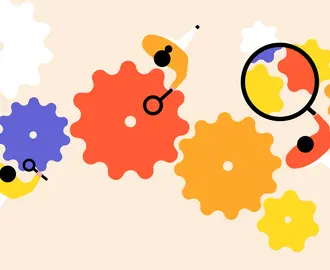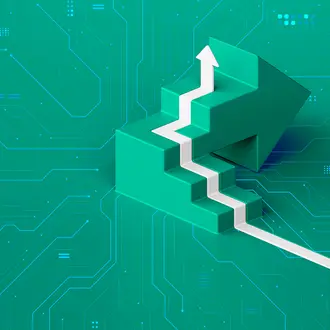Credit: Jennifer Tapias Derch
4 ways to design employee experience in the remote work era
Employee satisfaction isn’t just good for the work environment — it also makes companies stronger. Firms rated in the top 25% in terms of employee experience have the best business value, according to researchers from the MIT Center for Information Systems Research, who found that those companies also have higher customer satisfaction rates, are faster and more agile — and are more profitable.
Companies that build positive employee experiences enable workers through an adaptive work environment and collective work habits to do the work of today and to reimagine the work of tomorrow, according to Kristine Dery, a research scientist at CISR who focuses on the relationship between technology and how people work. And with widespread disruption from the COVID-19 pandemic, many companies have had to reimagine experience for employees scattered in thousands of different “workplaces” — their homes.
During a recent webinar, Dery and executives from CarMax and multinational law firm King & Wood Mallesons said longstanding roadblocks have faded during the work from home transition, as even reluctant companies or employees had to quickly embrace communication platforms and other technologies. At the same time, new challenges have emerged as companies attempt to recreate systems and working methods that worked in the office.
Here are four ways to design employee experiences in the coronavirus era:
Shift from survival to redesign
After several months of research about employee experiences during the pandemic, Dery said organizations tend to go through three phases.
During the survival phase, companies are focused on becoming operational and more connected by getting everyone up and running despite disruption, and making sure required hardware, software, and capabilities are in place. Communication often flows one way from the company to employees during this phase.
Eventually, companies move into the recreating and reimagining the employee experience phase — finding out what employees need to thrive again. Things become more chaotic as multiple demands emerge and what seemed to be working might turn out to be problematic. Pre-disruption difficulties become more enhanced, and problems might emerge as new tools and technologies are deployed. The key during this phase is to listen and work hard.
Finally, companies should move into the redesigning phase as they start to implement ways for employees to succeed in the COVID-19 environment and beyond. During this phase, look for data, insights, and stories to learn what’s sticking.
Move from a “culture of heroics” to processes and systems
Companies that deliver strong employee experiences deliberately move away from a culture of heroics, in which employees often have to go above and beyond to find ways to deliver for customers, becoming “heroes” in the organization, Dery said.
Instead of depending on heroic employees, companies should focus on processes and systems that can deliver for customers consistently and solve more complex problems. “Let’s figure those things out, and then let’s embed those into our organization, either through technology or through behaviors or through new metrics. That connection is much more systemic,” she said.
Implementing systems includes:
-Integrating operations across silos to make it easier for employees to innovate and deliver on the customer experience.
-Allowing seamless access to data and information about customers, putting power into the hands of employees to do what technology can’t do.
-Digitizing work, which allows for employee mobility — especially important now — and employee self-help.
-Using employee platforms, which allow employees to search for information and ideas, easily share knowledge, and reduce duplication.
Companies should also consider a dedicated customer experience team. “That phase where different employee experiences across the company were creating all sorts of quite chaotic decisions and responses was managed much more effectively by companies that had a dedicated [employee experience] team, that were looking at that right across the organization, and able to create more systemic accountability measures,” Dery said. These companies were able to get technology into the hands of employees faster, and could anticipate speed bumps ahead of time, instead of reacting to them after the fact.
Use empathetic leadership to make connections
Empathetic leadership is another driver of success, Dery said, as leaders ask employees to share concerns and where they need support. This doesn’t just mean soft caring skills, which are also important right now, Dery said. “It's really changing the whole dynamic of leadership within organizations and ways of thinking about what great leaders look like, in these more remote environments,” she said.
Firms rated in the top 25% in terms of employee experience have the best business value, according to researchers.
This was part of the work from home transition for employees at King & Wood Mallesons, which shifted to remote work in March, according to Michelle Mahoney, the executive director of innovation.
While the company first made sure employees had what they needed to work at home, King & Wood Mallesons also saw a significant increase in conversations and check-ins, Mahoney said. The company conducted employee surveys every two weeks — now every four weeks — about leadership, well-being, remote technology, and whether employees were able to continue delivering what was needed to clients.
Teams were eager to recreate line-of-sight management despite being disconnected, Mahoney said, leading to an increase in using digital Kanban boards, which allow teams to visualize work flows. “They love seeing the work for the week, reports of each day,” she said. “They know where it's going. They've had a huge impact around being more in control of what's coming.”
If anything, Mahoney said, connecting is proving too easy.
“One thing we haven’t been able to conquer … is about people being able to turn off,” Mahoney said. The company might have suggestions and advice about how to disconnect at the end of the day, she said, but people are still struggling with how to turn off “work mode.”
Enable empowered teams
Shamim Mohammad, senior vice president and chief information and technology officer at CarMax, said his company has benefited from cross-functional product teams — groups of seven to nine people who are given specific outcome goals to accomplish through experimenting, testing, and learning along the way. Every two weeks the teams present what they’ve accomplished to other product teams and members of the C-suite. Management has visibility and transparency into the work being done, while teams know their leaders have a vested interest in what they are doing.
CarMax is still using objectives and key results to measure car sales and company performance, though the smaller teams have specific business outcome goals, which easily aligns with remote work.
“We’re supporting them to go through this experimentation mindset,” Mohammad said. Especially now, “we cannot have all the people locked in a room, right? They're distributed, they're all over the place, and creativity really comes from the team, not from the leaders.”



